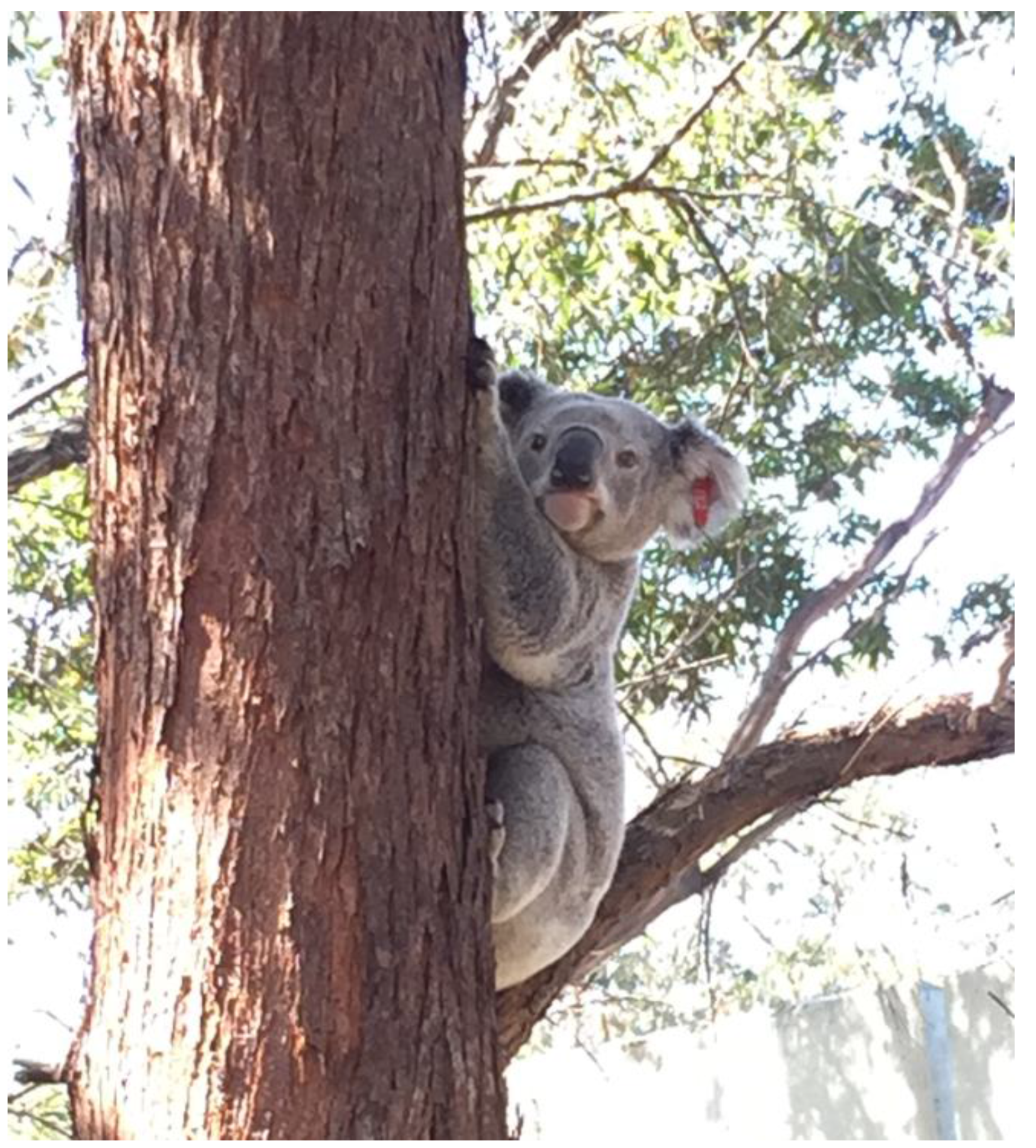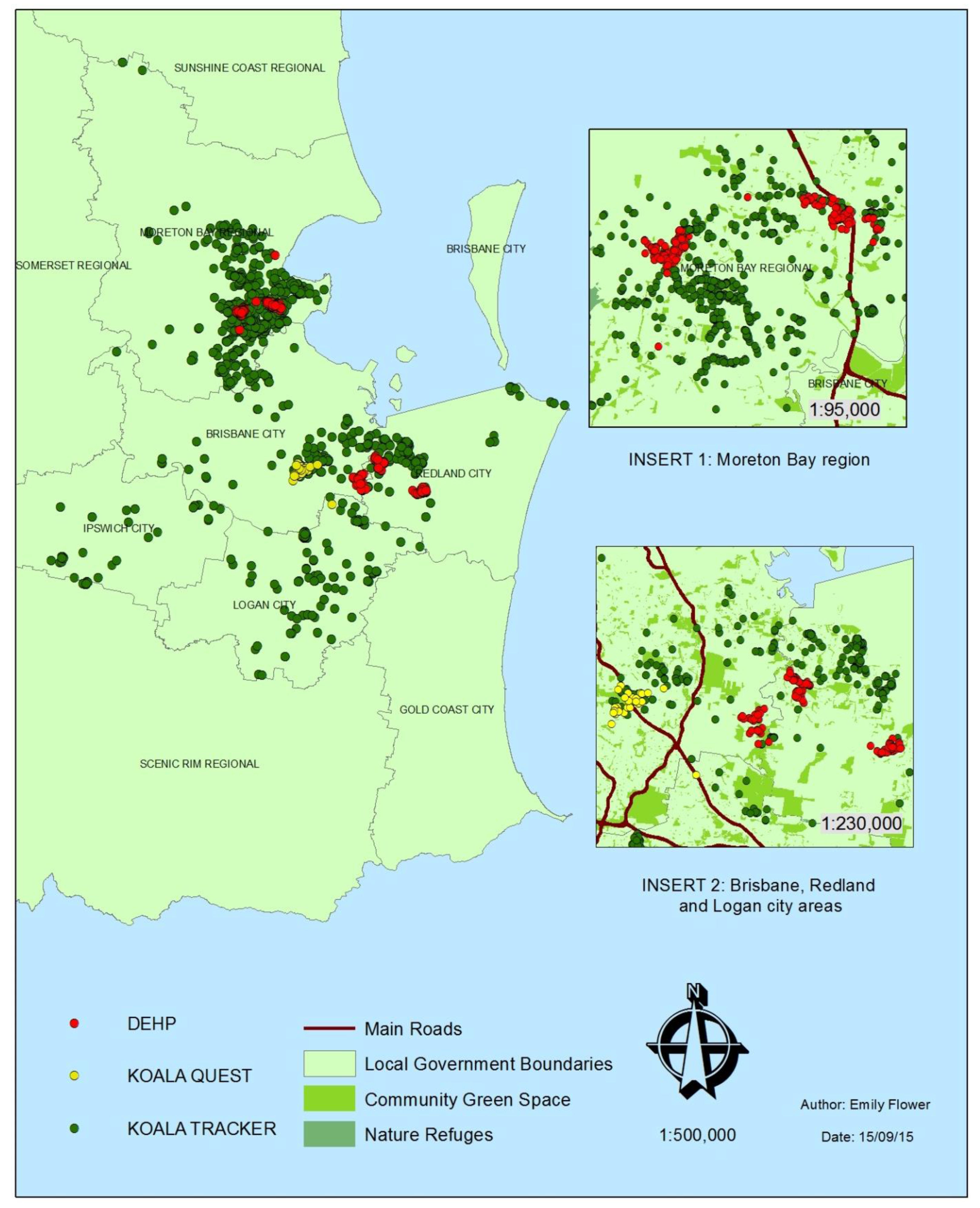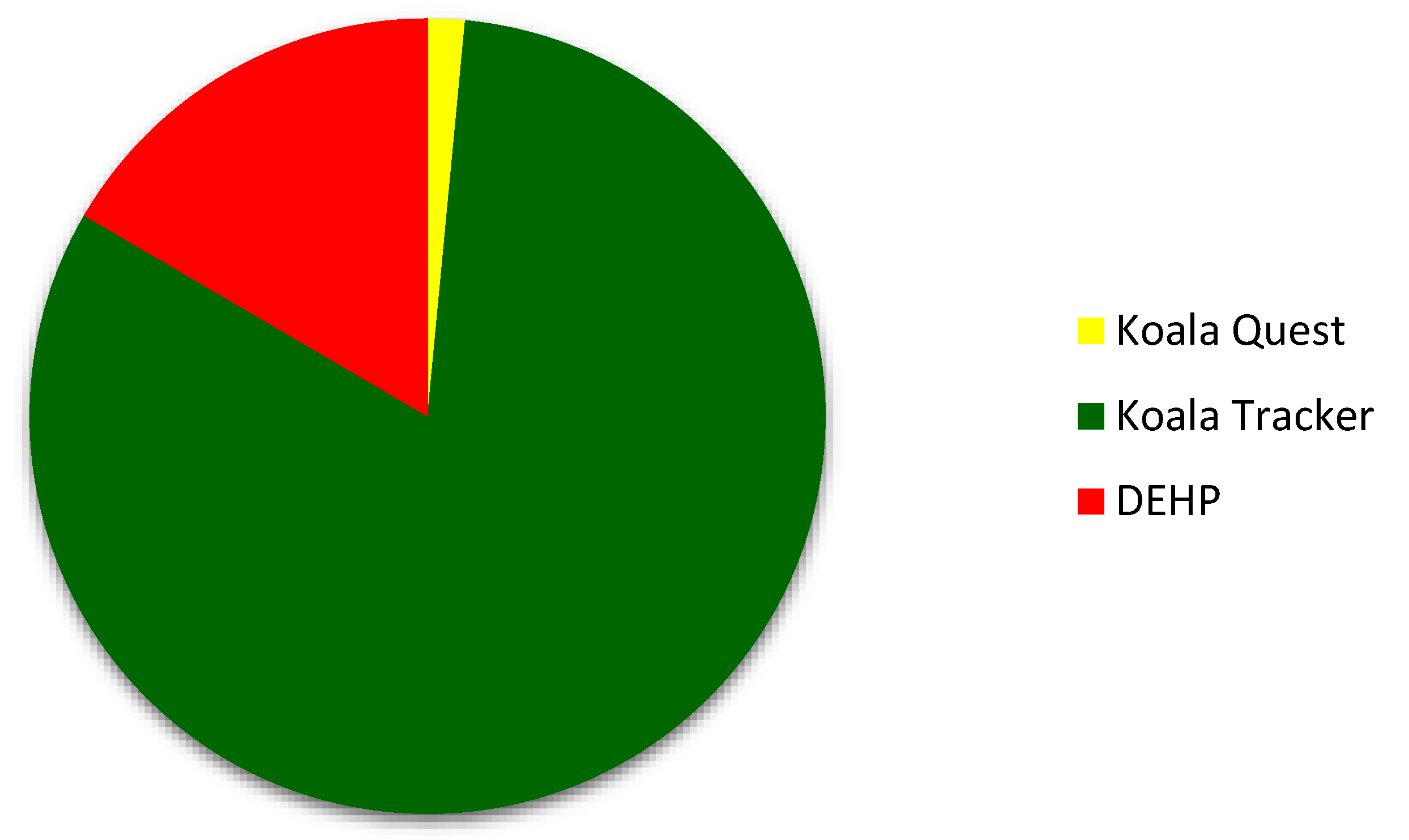Can Citizen Science Assist in Determining Koala (Phascolarctos cinereus) Presence in a Declining Population?
Abstract
:Simple Summary
Abstract
1. Introduction
1.1. The Evolving State of Citizen Science
Citizen Science Typologies
1.2. Benefits and Limitations of Citizen Science
1.3. Koala Population Monitoring
1.3.1. Background
1.3.2. Population Estimates
2. Materials and Methods
2.1. The Development of Guidelines for a Successful Citizen Science Project
2.2. Guidelines: Stages of a Citizen Science Project
2.2.1. Volunteer Recruitment
2.2.2. Data Validity
2.3. Koala Quest Project
2.3.1. Study Area
2.3.2. Volunteer Recruitment
2.3.3. Data Collection
2.3.4. Data Validity
2.3.5. Historical Data Sets
2.3.6. Presentation of Results
2.4. Human Ethics Statement
3. Results—Locating Koalas in the Greater Brisbane Region
3.1. Comparison of Koala Sightings Collected from Three Data Sources
4. Discussion
4.1. The Process of Developing Guidelines for a Citizen Science Project
4.1.1. Volunteer Recruitment
4.1.2. Data Collection Protocol
4.1.3. Data validity
4.2. Koala Quest, Koala Tracker and DEHP Data Source Comparison
4.3. Spatial Information Gained from Surveys
5. Recommendations for Future Studies
5.1. Volunteer Recruitment
5.2. Data Collection Protocol
5.3. Data Validity
6. Conclusions
Acknowledgments
Author Contributions
Conflicts of Interest
Abbreviations
| DEHP | Department of Environment and Heritage Protection |
| IUCN | International Union for the Conservation of Nature |
| NGO | Non-Government Organisation |
References
- Conrad, C.C.; Hilchey, K.G. A review of citizen science and community-based environmental monitoring: Issues and opportunities. Environ. Monit. Assess. 2010, 176, 273–291. [Google Scholar] [CrossRef] [PubMed]
- Franzoni, C.; Sauerman, H. Crowd science: The organisation of scientific research in open collaborative projects. Res. Policy 2014, 43, 1–20. [Google Scholar] [CrossRef]
- Sequeira, A.M.M.; Roetman, P.E.J.; Daniels, C.B.; Baker, A.K.; Bradshaw, C.J.A. Distribution models for koalas in South Australia using citizen-collected data. Ecol. Evol. 2014, 4, 2103–2114. [Google Scholar] [CrossRef] [PubMed]
- Cooper, C.B.; Dickinson, J.; Phillips, T.; Bonney, R. Citizen science as a tool for conservation in residential ecosystems. Ecol. Soc. 2007, 12, 11. [Google Scholar]
- Australian Government. The Koala—Saving our National Icon; Environment and Communications References Committee, Senate Printing Unit: Parliament House, Canberra, Australia, 2011.
- Shumway, N.; Lunney, D.; Seabrook, L.; McAlpine, C. Saving our national icon: An ecological analysis of the 2011 Australian Senate inquiry into status of the koala. Environ. Sci. Policy 2015, 54, 297–303. [Google Scholar] [CrossRef]
- McAlpine, C.A.; Lunney, D.; Melzer, A.; Menkhorst, P.; Phillips, S.; Phalen, D.; Ellis, W.; Foley, W.; Baxter, G.; de Villiers, D.; et al. Conserving koalas: A review of the contrasting regional trends, outlooks and policy changes. Biol. Conserv. 2015, 192, 226–236. [Google Scholar] [CrossRef]
- Conrad, C.T.; Daoust, T. Community-based monitoring frameworks: Increasing the effectiveness of environmental stewardship. Environ. Manag. 2008, 41, 358–366. [Google Scholar] [CrossRef] [PubMed]
- Lawrence, A. No personal motive? Volunteers, biodiversity, and the false dichotomies or participation. Ethics Place Environ. 2006, 9, 279–298. [Google Scholar] [CrossRef]
- Whitelaw, G.; Vaughan, H.; Craig, B.; Atkinson, D. Establishing the Canadian community monitoring network. Environ. Monit. Assess. 2003, 88, 409–418. [Google Scholar] [CrossRef] [PubMed]
- Sultana, P.; Abeyasekera, S. Effectiveness of participatory planning for community management of fisheries in Bangladesh. J. Environ. Manag. 2008, 86, 201–213. [Google Scholar] [CrossRef] [PubMed]
- Lakshminarayanan, S. Using citizens to do science versus citizens as scientists. Ecol. Soc. 2007, 12, r2. [Google Scholar]
- Bruce, E.; Albright, L.; Sheehan, S.; Blewitt, M. Distribution patterns of migratory humpback whales (Megaptera novaeangliae) in Jervis Bay, Australia: A spatial analysis using geographical citizen science data. Appl. Geogr. 2014, 54, 83–95. [Google Scholar] [CrossRef]
- Hollow, B.; Roetman, P.E.J.; Walter, M. Citizen Science for policy development: The case of koala management in South Australia. Environ. Sci. Policy 2015, 47, 126–136. [Google Scholar] [CrossRef]
- Dickinson, J.L.; Zuckerberg, B.; Bonter, D.N. Citizen science as an ecological research tool: Challenges and benefits. Annu. Rev. Ecol. Evol. Syst. 2010, 41, 149–172. [Google Scholar]
- Cooper, C.B.; Hachachka, W.M.; Dhondt, A.A. The opportunities and challenges of citizen science as a toll for ecological research. In Citizen Science: Public Participation in Environmental Research; Dickinson, J.L., Bonney, R., Eds.; Comstock Publishing Associates: Ithaca, NY, USA, 2012; pp. 99–113. [Google Scholar]
- Fink, D.; Hochachka, W.M. Using data mining to discover biological patterns in citizen science observations. In Citizen Science: Public Participation in Environmental Research; Dickinson, J.L., Bonney, R., Eds.; Comstock Publishing Associates: Ithaca, NY, USA, 2012; pp. 125–138. [Google Scholar]
- Bonter, D.N.; Cooper, C.B. Data validation in citizen science: A case study from Project FeederWatch. Front. Ecol. Environ. 2012, 10, 305–307. [Google Scholar] [CrossRef]
- Delaney, D.G.; Sperling, C.D.; Adams, C.S.; Leung, B. Marine invasive species: Validation of citizen science and implications for national monitoring networks. Biol. Invasions 2008, 10, 117–128. [Google Scholar] [CrossRef]
- Fitzpatrick, M.C.; Preisser, E.L.; Ellison, A.M.; Elkinton, J.S. Observer bias and the detection of low-density populations. Ecol. Appl. 2009, 19, 1673–1679. [Google Scholar] [CrossRef] [PubMed]
- McAlpine, C.A.; Fensham, R.J.; Temple-Smith, D.E. Biodiversity conservation and vegetation clearing in Queensland: principles and thresholds. Rangel. J. 2002, 24, 36–55. [Google Scholar] [CrossRef]
- Melzer, A.; Carrick, F.; Menkhorst, P.; Lunney, D.; St John, B. Overview, critical assessment, and conservation implications of koala distribution and abundance. Conserv. Biol. 2000, 14, 619–628. [Google Scholar] [CrossRef]
- Phillips, B. Koalas. The Little Australian’s We’d All Hate to Lose; AGPS Press: Canberra, Australia, 1990. [Google Scholar]
- IUCN. Phascolarctos Cinereus. Available online: http://www.iucnredlist.org/details/16892/0 (accessed on 18 April 2015).
- Queensland Government. The Queensland Cabinet and Ministerial Directory. Available online: http://statements.qld.gov.au/Statement/2015/5/31/queenslands-koalas-to-be-listed-asvulnerable (accessed on 24 August 2015).
- Braithwaite, L.W. Do current forest practices threaten forest fauna? A perspective. In Conservation of Australia’s Forest Fauna, 2nd ed.; Lunney, D., Ed.; Royal Zoological Society of New South Wales: Mosman, Australia, 2004; pp. 513–536. [Google Scholar]
- Moore, B.D.; Foley, W.J. Tree use by koalas in a chemically complex landscape. Nature 2005, 435, 488–490. [Google Scholar] [CrossRef] [PubMed]
- Moore, B.D.; Wallis, I.R.; Marsh, K.J.; Foley, W.J. The role of nutrition in the conservation of marsupial folivores of eucalypt forests. In Conservation of Australia’s Forest Fauna, 2nd ed.; Lunney, D., Ed.; Royal Zoological Society of NSW: Mosman, Australia, 2004; pp. 549–575. [Google Scholar]
- Dique, D.S.; Preece, H.J.; Thompson, J.; Villiers, D. Determining the distribution and abundance of a regional koala population in south-east Queensland for conservation management. Wildl. Res. 2004, 31, 109–117. [Google Scholar]
- Department of Environment and Resource Management (DERM). Decline of the Koala Coast Population: Population Status in 2010; Queensland Government: Brisbane, Australia, 2012.
- Sullivan, B.J.; Baxter, G.S.; Lisle, A.T. Low-density koala (Phascolarctos cinereus) populations in the mulgalands of south-west Queensland. III. Broad-scale patterns of habitat use. Wildl. Res. 2003, 30, 583–591. [Google Scholar] [CrossRef]
- Department of Environment and Resource Management (DERM). Decline of the Koala Coast Population: Population Status in 2008; Queensland Government: Brisbane, Australia, 2009.
- Lee, K.E.; Seddon, J.M.; Corley, S.; Ellis, W.A.H.; Johnston, S.D.; de Villiers, D.L.; Preece, H.J.; Carrick, F.N. Genetic variation and structuring in the threatened koala populations of south-east Queensland reveals a genetically distinct population in the Koala Coast. Conserv. Genet. 2009, 11, 2091–2103. [Google Scholar] [CrossRef]
- Wilmer, J.; Melzer, A.; Carrick, F.; Moritz, C. Low genetic diversity and inbreeding depression in Queensland koalas. Wildl. Res. 1993, 20, 177–187. [Google Scholar] [CrossRef]
- Cohn, J.P. Citizen science: Can volunteers do real research? BioScience 2008, 58, 192–197. [Google Scholar] [CrossRef]
- Mullen, M.W.; Allison, B.E. Stakeholder involvement and social capital: Keys to watershed management success in Alabama. J. Am. Water Resour. Assoc. 1999, 35, 655–662. [Google Scholar] [CrossRef]
- Bonney, R.; Cooper, C.B.; Dickinson, J.; Kelling, K.; Phillips, T.; Rosenberg, K.V.; Shirk, J. Citizen science: A developing tool for expanding science knowledge and scientific literacy. BioScience 2009, 59, 977–984. [Google Scholar] [CrossRef]
- Mulder, R.A.; Guay, P.-J.; Wilson, M.; Coulson, G. Citizen science: Recruiting residents for studies of tagged urban wildlife. Wildl. Res. 2010, 37, 440–446. [Google Scholar] [CrossRef]
- Lunney, D.; Matthews, A.; Moon, C.; Ferrier, S. Incorporating habitat mapping into practical koala conservation on private lands. Biol. Conserv. 2000, 14, 669–680. [Google Scholar] [CrossRef]
- Lawrence, R.L.; Deagan, D.A. Choosing public participation methods for natural resources: A Context-specific guide. Soc. Nat. Resour. 2001, 14, 857–872. [Google Scholar] [CrossRef]



| Author | Study Focus | Points Used towards the Development of Guidelines |
|---|---|---|
| Bruce et al., 2014 | Educating volunteers in citizen science (CS) projects |
|
| Bonter and Cooper, 2012 | How to ensure data validity (case study) |
|
| Cohn, 2008 | Benefits of CS and gathered feedback from volunteers |
|
| Conrad and Hilchey, 2010 | Literature review of past 10 years to find common benefits, challenges, and recommendations for successful CS projects |
|
| Cooper et al., 2007 | Find a method to conserve wildlands in urban environments |
|
| Franzoni and Sauerman, 2014 | Systematic understanding of CS and conceptual framework and agenda for future research |
|
| Hollow et al., 2015 | CS is useful for policy development and gathered feedback from volunteers (survey) |
|
| Mulder et al., 2010 | Volunteer recruitment and retention strategies |
|
| Raddick et al., 2009 | Importance and benefits of CS—aims to make CS commonplace |
|
| Sequeira et al., 2014 | Predicting species distribution (koala case study) |
|
| Silvertown, 2009 | Reasons for increased use of CS |
|
| Wiggins and Crouston, 2011 | CS typologies–identified 5 types of project characteristics |
|
© 2016 by the authors; licensee MDPI, Basel, Switzerland. This article is an open access article distributed under the terms and conditions of the Creative Commons Attribution (CC-BY) license (http://creativecommons.org/licenses/by/4.0/).
Share and Cite
Flower, E.; Jones, D.; Bernede, L. Can Citizen Science Assist in Determining Koala (Phascolarctos cinereus) Presence in a Declining Population? Animals 2016, 6, 42. https://doi.org/10.3390/ani6070042
Flower E, Jones D, Bernede L. Can Citizen Science Assist in Determining Koala (Phascolarctos cinereus) Presence in a Declining Population? Animals. 2016; 6(7):42. https://doi.org/10.3390/ani6070042
Chicago/Turabian StyleFlower, Emily, Darryl Jones, and Lilia Bernede. 2016. "Can Citizen Science Assist in Determining Koala (Phascolarctos cinereus) Presence in a Declining Population?" Animals 6, no. 7: 42. https://doi.org/10.3390/ani6070042
APA StyleFlower, E., Jones, D., & Bernede, L. (2016). Can Citizen Science Assist in Determining Koala (Phascolarctos cinereus) Presence in a Declining Population? Animals, 6(7), 42. https://doi.org/10.3390/ani6070042





